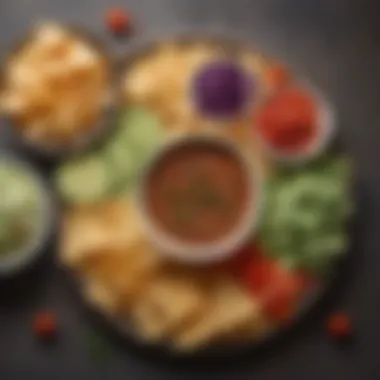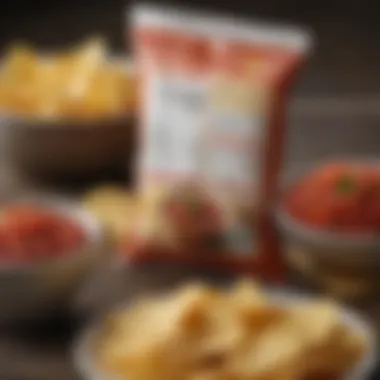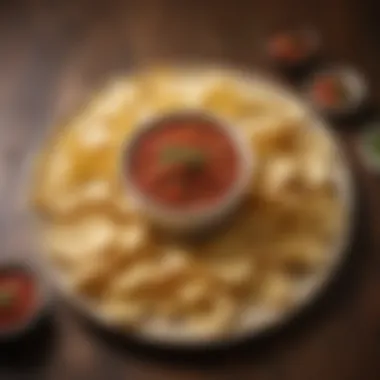Chips and Salsa: A Weight Loss Snack Analysis


Intro
In discussions about weight loss, snacks often receive criticism. However, chips and salsa may offer a unique case worth examining. This article aims to demonstrate how this popular snack can potentially fit into a weight loss plan. By breaking down the nutritional components of both chips and salsa, we can better understand their caloric contributions and overall impact on satiety and diet.
While usually considered indulgent, these ingredients can lead to satisfying choices if one understands their properties and portion sizes. The forthcoming sections will explore the elements of chips and salsa, highlighting their origins, ingredient quality, and suitable serving strategies.
Recipe Overview
Brief Description of the Dish
Chips and salsa is a very simple, yet delightful combination that often finds its place at parties and casual gatherings. Typically, tortilla chips are accompanied by a fresh salsa made from tomatoes, onions, chilies, and seasonings. The contrast between the crunchy texture of chips and the zesty flavors of salsa can offer a compelling snack or appetizer choice.
Origin and Cultural Significance
Chips and salsa have roots in Mexican and Tex-Mex cuisine. Tortilla chips originated in Mexico, where they were often made from corn tortillas cut into triangles, then fried or baked. Salsa, on the other hand, translates to sauce in Spanish and has numerous variations. The introduction of salsa as a dip is relatively akin to the rise of Tex-Mex cuisine.
Together, they represent a cultural blend, embodying traditions and culinary practices that span regions. This dish not only features in casual dining but also presents a method for communal engagement, encouraging sharing and conversation.
Ingredients List
Complete List of Ingredients
When preparing chips and salsa, you typically require the following items:
- Tortilla Chips
- Tomatoes
- Onions
- Cilantro
- Lime Juice
- Chili Peppers (e.g. jalapeños)
- Salt
Special Ingredient Notes
- Tortilla Chips: Opt for baked varieties when possible. They usually contain less fat and calories compared to their fried counterparts.
- Fresh Ingredients: Using local and seasonal produce for salsa can improve the dish's nutritional profile and flavor.
- Replacements: Consider whole-grain or corn chips for an added fiber boost. If making salsa, avocados can also be incorporated for creaminess without excessive calories.
- Sourcing Tips: Look for organic ingredients or those from local farms for quality assurance.
Understanding these components plays a critical role in navigating the potential of chips and salsa in one's dietary habits.
Prolusion to Chips and Salsa
Chips and salsa holds a prominent place in various culinary traditions, particularly in Mexican and Tex-Mex cuisines. The combination is culturally significant, serving not only as a snack but also as an appetizer or side dish during meals. Understanding the dynamics of this pairing can clarify its potential role in a weight loss strategy.
The popularity of chips and salsa is not merely a trend. Both components present unique flavors and textures that attract diverse audiences. This appeal makes them a desirable choice for social gatherings and casual meals alike. However, with increasing interest in health and nutrition, it is essential to evaluate how these items can fit into a weight loss regimen.
Chips often serve as a crunchy foundation, while salsa provides a contrasting freshness. This interplay adds to their overall appeal and enjoyment. Yet, it is crucial to discern the nutritional implications of consuming chips and salsa. Different types of chips have varying calorie counts, fat content, and processing levels. Meanwhile, salsa's ingredient list can range from simple tomato-based mixes to more complex variations.
By exploring the importance of chips and salsa in the context of weight loss, we can provide insights into how to enjoy this popular combination without straying from health goals.
Culinary Popularity
Chips and salsa represent a culinary phenomenon with roots deeply embedded in various cultures. Their widespread popularity transcends geographical boundaries, making them a common choice at parties, restaurants, and home gatherings. The pairing is often associated with festive occasions and communal dining, enhancing the experience for those who partake.
Moreover, this duo is not limited to just one style. Variants exist, catering to different tastes and preferences. Some people opt for corn chips, while others prefer tortilla or even baked alternatives. Likewise, the salsa can vary widely, from traditional tomato salsa to innovative fruit-based versions. This culinary flexibility is vital for maintaining interest and appeal in the long term.
Traditional Pairing
Traditionally, chips and salsa coexist harmoniously, often served as an appetizer or snack. In many cultures, offering chips and salsa to guests signifies hospitality and a warm welcome. The vibrant colors and textures elicit anticipation, making them a staple at gatherings.
Despite their popularity, it is interesting to note the varying palate preferences across regions. For example, Southwestern U.S. regions may embrace spicier salsas compared to milder versions favored elsewhere. The choice of dip also varies based on dietary restrictions and nutritional goals. Acknowledging these nuances is crucial for a comprehensive understanding of chips and salsa.
Nutritional Overview of Chips
Understanding the nutritional profile of chips is crucial when considering them as a part of a weight loss plan. This section outlines the types of chips commonly found in stores and their specific attributes, helping to inform better snack choices that can align with health goals. The total caloric content, alongside the breakdown of fats and carbohydrates, will provide insight into how make chips work for, or against, weight loss efforts.


Types of Chips
Corn Chips
Corn chips are made primarily from cornmeal, which is a significant aspect of their composition. They tend to have a crunchy texture and are often seen as a traditional snack. The key characteristic of corn chips is their simple ingredient list, usually comprising of corn, oil, and salt. This makes them a cleaner option compared to other snacks filled with additives.
One unique feature of corn chips is their ability to provide a satisfying crunch, which can contribute to satiety. However, they often have high salt content, which can be a drawback for those monitoring sodium intake. In moderate portions, corn chips can offer a tasty, relatively nutritious snack option for those aiming for weight loss.
Tortilla Chips
Tortilla chips are similar to corn chips but are typically made from corn tortillas that are fried or baked. The defining characteristic of tortilla chips is their versatility. They can be enjoyed alone or paired with various salsas and dips.
Tortilla chips are popular because they are often considered a healthier alternative. They can come in baked varieties, which have lower fat content than their fried counterparts. However, the calorie count can still add up quickly when consumed in large amounts. Their full flavor can promote portion control but can also lead to overeating if not careful.
Potato Chips
Potato chips represent another common choice. They are made from thin slices of potatoes that are fried until crispy. The key characteristic of potato chips is their indulgent flavor and texture. They are often seasoned with various flavors, which makes them appealing to many snack consumers.
While potato chips can provide a satisfying crunch, they generally have a higher caloric density compared to corn chips. This makes them less ideal for weight loss efforts unless consumed in very small portions. The unique feature of potato chips is their wide variety of flavors, which can entice snackers, but this variety comes with the risk of consuming more calories than intended.
Caloric Content
Each type of chip carries a different caloric profile, making it essential to evaluate which chips fit best within a weight loss strategy. Corn chips usually contain around 140-150 calories per ounce. Tortilla chips can range from 130-160 calories per ounce depending on how they are cooked. Potato chips, however, can easily exceed 150-200 calories per ounce, especially those made with additional flavoring agents.
Understanding these values helps in making educated decisions about snacking without the negative impact on caloric intake.
Fat and Carbohydrate Profiles
Analyzing the fat and carbohydrate profiles of chips provides further insights into their nutritional impact. Corn chips generally contain a moderate amount of fat, around 6-8 grams per serving, primarily from the oil used in production. In terms of carbohydrates, they can offer about 15-18 grams per serving, which can contribute to energy needs without excessive spikes in blood sugar.
Tortilla chips appear similar with fat content ranging around 7-10 grams. Their carbohydrate level is comparable as well, contributing positively to the satiety factor when eaten in moderation.
Potato chips typically contain higher fat levels, around 10-12 grams per serving. Their carbohydrate content is also significant, with values reaching 15-20 grams. This makes potato chips the less favorable option for those trying to curb weight gain.
Nutritional Overview of Salsa
The nutritional overview of salsa is critical when assessing its role in weight loss. Salsa can be a low-calorie and nutrient-rich addition to meals, offering various health benefits. Understanding the composition of salsa helps in evaluating how it can fit into dietary strategies designed for weight management.
Ingredients and Variations
Tomato Salsa
Tomato salsa primarily consists of tomatoes, onions, cilantro, and lime juice. This combination provides a fresh and tangy flavor that enhances many dishes. The key characteristic of tomato salsa is its rich lycopene content, a powerful antioxidant linked to reduced cancer risk. This makes tomato salsa a beneficial addition to the diet. However, the sodium content can vary, particularly in commercially prepared versions, thus keeping an eye on labels is important for maintaining low sodium intake.
Pico de Gallo
Pico de gallo is a fresh salsa made of diced tomatoes, onions, cilantro, jalapeño, and lime juice. Its bright flavors and crunchy texture make it a popular choice. A notable feature of pico de gallo is its low calorie count while still offering a good source of vitamins A and C. The simplicity of its ingredients preserves the nutrients well. The only disadvantage to consider is that fresh pico can spoil quickly, requiring careful preparation and storage methods.
Fruit Salsas
Fruit salsas often include ingredients like mango, pineapple, or peach combined with spices and herbs. They provide a unique twist on traditional salsa. The highlight of fruit salsas is their natural sweetness, making them appealing even to those avoiding vegetables. They offer additional vitamins and can add variety to meals, which is beneficial for dietary adherence. However, dieters should be mindful of the sugar content in some fruits that can contribute to increased calories if consumed in large amounts.
Caloric Benefits
Salsa, especially in its fresh forms, is generally low in calories. A typical serving might contain only 10 to 30 calories, depending on the ingredients. This aspect makes it an appealing choice for those mindful of caloric intake. When considering chips, adding salsa can enhance flavor without significantly increasing caloric consumption, making it easier to feel satisfied without overindulging.
Dietary Fiber Contribution


Salsa can also contribute to daily fiber intake, although the amount varies by type. The fresh vegetables in salsa provide fiber, which promotes digestive health and enhances satiety, making one feel fuller longer. This is particularly valuable for weight loss plans, as it helps control hunger and can lead to reduced overall caloric intake. Including fiber-rich foods is an effective strategy for weight management.
Fresh salsa may support your weight loss journey by boosting nutrient intake while remaining low in calories and high in fiber.
Evaluating the Weight Loss Potential
When considering chips and salsa in the context of weight loss, it is vital to assess how these snack choices can influence dietary goals. This section focuses on the unique aspects of both components, examining how they contribute to or detract from weight management strategies. Recognizing the caloric density, ingredient quality, and overall satisfaction level of these snacks can enable informed decisions. The succeeding subsections dive deeper into how satiety impacts overall caloric intake and how portion sizes play a crucial role in controlling consumption.
Satiety Considerations
Satiety, or the feeling of fullness, is key when evaluating any food for weight loss. Chips and salsa are often consumed together, and their combination may offer a sense of satisfaction for many individuals. However, it is necessary to consider the satiety potential of both elements independently.
Research indicates that foods high in fiber and water content foster greater satiety. Salsa, particularly varieties like pico de gallo or fruit salsas, often contains tomatoes, onions, and peppers, which are not only low in calories but also rich in fiber. This can enhance the feeling of fullness, encouraging one to consume fewer calories overall.
On the other hand, the chips are typically made from corn, potatoes, or other ingredients that may not provide the same level of fiber, leading to quicker feelings of hunger. Hence, pairing high-fiber salsa with lower-fiber chips can create a balance in satisfying hunger without excessive calorie intake.
To optimize satiety:
- Combine chips with a generous serving of salsa.
- Consider whole grain or baked chips as they may provide more fiber.
- Include plenty of vegetables in the salsa for added volume.
"Choosing the right ingredients in salsa can significantly improve satiety and enhance your weight loss efforts."
Impact of Portion Sizes
Another essential factor in evaluating the weight loss potential is understanding portion sizes. Chips and salsa can quickly transform from a moderation-friendly snack to a calorie-dense meal if portion sizes are not managed effectively.
Chips tend to be easy to overconsume. A single serving might seem small, but many people have difficulty limiting themselves to this amount. On average, a serving of tortilla chips can contain around 140 to 160 calories, which can add up rapidly.
In contrast, salsa is generally much lower in calories. Depending on the ingredients and preparation, a half-cup of salsa can be as few as 25 to 50 calories. Therefore, while the chips contribute more to the caloric total, careful attention to portion sizes can help mitigate their negative impact.
Practical strategies for managing portion sizes include:
- Use smaller bowls for chips to limit consumption.
- Measure out chips beforehand instead of eating directly from the bag.
- Feel free to increase the serving of salsa since it is mostly low in calories.
Overall, evaluating the weight loss potential of chips and salsa requires critical consideration of both satiety and portion sizes. By understanding these aspects, individuals can incorporate this popular snack into their diets in a more health-conscious manner.
Creating Healthier Versions of Chips and Salsa
The concept of Creating Healthier Versions of Chips and Salsa is vital in the context of weight management. Traditional chips and salsa can often lack nutritional value or contain excessive calories, which may hinder weight loss efforts. By modifying these staples, one can not only achieve a more balanced snack but also enjoy flavors that align with health goals. It is beneficial for those who appreciate snacks, enabling them to indulge without guilt.
Baked vs. Fried Chips
When considering chips, there’s a significant distinction between baked and fried options. Baked chips generally contain fewer calories and less fat than their fried counterparts. The frying process adds oil, which increases caloric content substantially. For example, a serving of fried potato chips can contain up to 150 calories, while baked versions may only have around 100 calories, largely depending on the brand and recipe.
Moreover, baking allows for different flavors to be introduced without adding unnecessary fats. Spices like paprika, garlic powder, and chili powder can transform a simple baked chip into a savory delight without compromising health.
It's essential to read labels when selecting chips. While baked varieties are often marketed as healthier, some brands compensate for the lack of fat by adding sugars or excessive sodium. Consuming baked chips in moderation can certainly fit into a weight loss plan if combined with sensible portion control.
Fresh Salsa Recipes
Fresh salsa recipes offer a wide range of low-calorie flavor enhancers that can complement healthier chips. Making salsa from scratch not only ensures quality ingredients but also allows for customization. Tomatoes, onions, cilantro, and lime juice are classic ingredients, but one can easily introduce variations such as peppers or mango to enhance taste and nutritional value.
A simple recipe could involve:
- 2 medium tomatoes, diced
- 1/4 onion, finely chopped
- A handful of cilantro, chopped
- Juice of 1 lime
- Salt and pepper to taste
This fresh concoction can provide significant dietary fiber and antioxidants while keeping calories very low. Furthermore, fruits salsas, like those incorporating mango or pineapple, can add a unique sweetness without resorting to added sugars. Using fresh ingredients can turn humble salsa into a nutrient-rich topping, enhancing the overall taste experience while maintaining health standards.


Integrating Chips and Salsa into a Balanced Diet
Integrating chips and salsa into a balanced diet can be a beneficial approach if done judiciously. This section explores how these popular snacks can complement meals and contribute to overall dietary habits while still considering weight loss goals. Emphasizing balance is key.
Complementing Meals
Chips and salsa can serve as more than just a snack; they can enhance meals when integrated thoughtfully. This snack can work well with various dietary components. For example, adding salsa to grilled chicken or fish can provide flavor without excessive calories. Additionally, using tortilla chips as a side to bean dishes can add crunch and texture, making the meal enjoyable.
Some possible combinations to consider include:
- Chips and salsa with a fresh salad: This adds a crunch to your greens and can help with satiety.
- Salsa as a dressing alternative: Utilizing salsa instead of heavier dressings can lower calorie intake.
- Chips as a vehicle for healthy dips: Pairing chips with guacamole or hummus can enrich the nutrient profile.
These combinations can enhance the dining experience while maintaining a focus on moderation. Being aware of portion sizes is essential, as chips can quickly add calories.
Timing and Frequency
The timing and frequency of consuming chips and salsa are also critical factors. Eating these snacks at appropriate times can promote better digestion and enhanced enjoyment of meals. Consideration of meal structure is important. For instance, consuming chips and salsa before meals may prevent overeating.
More points to consider include:
- Consider snack timing: Have chips and salsa as a mid-afternoon snack or part of a pre-dinner spread. This reduces overeating at main meals.
- Frequency: Make chips and salsa an occasional treat rather than a daily staple. This helps control calorie intake while still enjoying the flavors.
- Mindful eating: Practicing mindfulness while enjoying chips and salsa can help recognize satiety signals, reducing the urge to overindulge.
Integrating chips and salsa into your meals should focus on balance and mindfulness.
By understanding how to complement meals and manage the timing of consumption, chips and salsa can fit into a healthy lifestyle without compromising weight loss efforts.
Potential Drawbacks
When considering chips and salsa as part of a weight loss strategy, it is crucial to evaluate potential drawbacks that may undermine the benefits. These drawbacks can include high sodium content and the presence of additives and preservatives in commercial products. Understanding these elements will help individuals make informed choices about incorporating chips and salsa into their diets.
High Sodium Content
Sodium is an essential mineral used by the body to function properly, but its overconsumption can lead to health issues. Many types of commercial chips and salsas are high in sodium. A single serving of tortilla chips can contain more than 200 milligrams of sodium, while some salsas may add another 200 to 400 milligrams. This can quickly accumulate, especially if one indulges in multiple servings.
High sodium intake can lead to increased blood pressure, a significant risk factor for heart disease and stroke. When choosing chips and salsa, one should be mindful of their sodium levels. It is advisable to check product labels for sodium content and select brands that offer lower-sodium options. Alternatively, making homemade salsa can allow for greater control over the amount of salt added, enabling healthier snacking choices.
Additives and Preservatives in Commercial Products
Commercial chips and salsa often contain additives and preservatives to enhance flavor, shelf life, and appearance. Common additives include monosodium glutamate (MSG), artificial flavors, and colorants. While these ingredients may make products more appealing, their long-term effects on health are still not fully understood.
For those focused on weight loss and overall health, it is sensible to be cautious about these ingredients. Opting for products with fewer additives or checking labels for natural ingredients can improve dietary quality. Many people are turning to fresh ingredients and homemade versions, which can diminish the likelihood of consuming unwanted chemicals.
In summary, recognizing the potential drawbacks of high sodium content and additives in commercial products allows consumers to make educated decisions. Prioritizing healthier alternatives can help maintain the pleasure of enjoying chips and salsa while staying committed to weight management goals.
Finale
In evaluating chips and salsa as a weight loss snack, it becomes essential to consider several facets that encapsulate the overall health implications. This concluding section synthesizes the information discussed throughout the article and emphasizes the importance of informed choices when indulging in these popular snacks. Understanding the nutritional profiles of both chips and salsa guides the individual towards making better health decisions without completely sacrificing enjoyment in their diet.
The analysis of chips reveals a broad spectrum of options, from traditional corn chips to baked alternatives, each with varying caloric and fat content. Similarly, salsa offers a wealth of choices, often featuring fresh ingredients that provide not just flavor, but also nutritional benefits. Therefore, it is straightforward to integrate chips and salsa into a balanced diet while being strategic about portion sizes. Developing a keen awareness of caloric intake and nutritional quality plays a critical role in successful weight management.
In understanding the potential drawbacks, particularly high sodium content and the presence of additives, consumers are reminded to check labels carefully. Shifting towards homemade products can mitigate these concerns significantly.
Promoting healthier versions is pivotal, as demonstrated through recommendations for baked chips and fresh salsas that utilize wholesome ingredients. This is where creativity comes into play, encouraging the exploration of various flavors and textures without depriving oneself of the culinary experience.
Lastly, the conclusion of any dietary journey rests on a key point—the integration of snacks like chips and salsa can be done thoughtfully and beneficially, as long as it aligns with personal health goals. Fostering a positive relationship with food while remaining pragmatic about choices reinforces the sustainability of dietary habits in the long term.
Final Thoughts on Weight Loss and Snack Choices
When considering weight loss, one must remember that snacks can contribute positively if chosen wisely. Chips and salsa should not be viewed as mere indulgences but rather as components of a larger nutritional strategy.
- Mindful Eating: Engaging in mindful snacking encourages individuals to savor each bite, acknowledging the flavors and textures while controlling portions.
- Quality over Quantity: Opt for high-quality ingredients, especially in salsa. Fresh tomatoes, herbs, and spices vastly improve the health profile compared to store-bought options laden with preservatives.
- Balance and Moderation: No food should be completely off-limits. Enjoying chips and salsa in moderation can create a sustainable approach to eating, allowing for variety and satisfaction.
Ultimately, the decision to include chips and salsa in your diet hinges on awareness. By making calculated choices rooted in understanding their nutritional value, one can align their snacking habits with their weight loss objectives. The journey towards health is nuanced, and recognizing the role of enjoyable snacks is a crucial piece of the puzzle.



